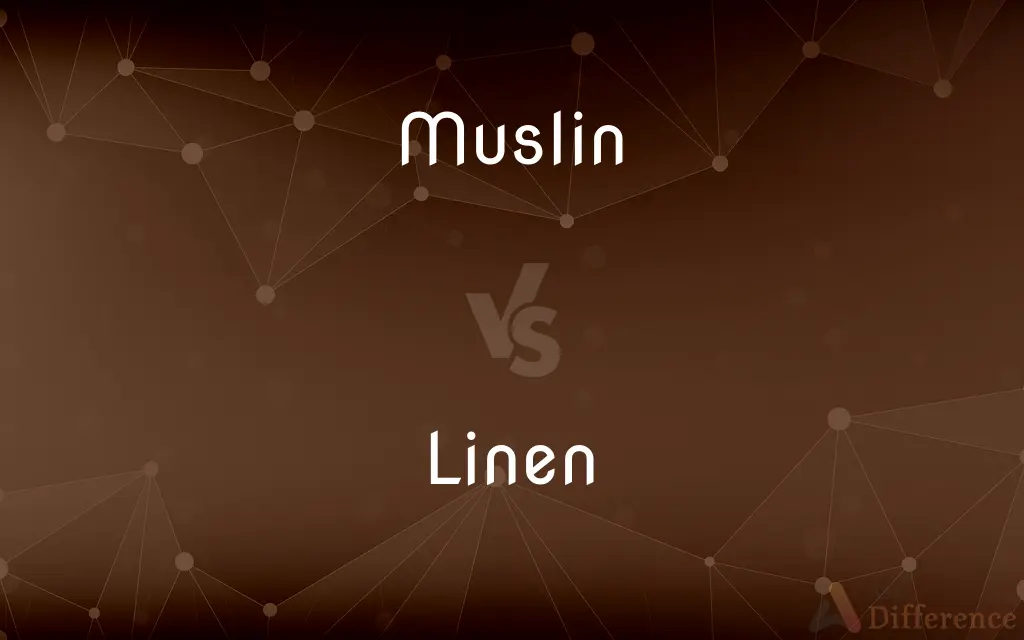Muslin vs. Linen — What's the Difference?
Edited by Tayyaba Rehman — By Maham Liaqat — Updated on March 7, 2024
Muslin is a lightweight, cotton fabric known for its breathability, often used in dressmaking and curtains, while linen is a durable, natural fiber from flax plants, popular for clothing and household items due to its strength and coolness.

Difference Between Muslin and Linen
Table of Contents
ADVERTISEMENT
Key Differences
Muslin is a soft, finely woven fabric made from cotton, known for its delicacy and lightweight nature, making it ideal for summer clothing, baby swaddles, and as a backing or lining material in quilting and dressmaking. It's breathable and comfortable, often used in a variety of lightweight applications. On the other hand, linen is made from the fibers of the flax plant, offering a crisp, textured feel that becomes softer with each wash. Linen is highly appreciated for its natural luster, durability, and ability to stay cool and fresh, even in hot weather, making it a preferred choice for bedding, apparel, and table linens.
Muslin, due to its lightweight and open weave, tends to wrinkle less than linen. It's also generally more affordable, making it a popular choice for mock-ups in garment construction or for use in settings where an economical option is desirable. Whereas linen is valued for its strong, absorbent, and quick-drying qualities, which contribute to its higher price point. Linen's unique texture and weight also lend it a distinct appearance and feel that many find superior for fashion and home décor.
The care requirements for muslin and linen differ slightly due to their respective fibers and weave. Muslin is easy to care for, often requiring just a simple wash and gentle dry, making it a low-maintenance choice for everyday use. Linen, while also washable, may require more attention to avoid excessive wrinkling and to preserve its quality, including potential ironing and specific drying instructions.
Muslin is often chosen for its softness and gentleness against the skin, which is especially important in products for infants and sensitive skin. Its gauzy quality allows for excellent air circulation, reducing the risk of overheating. Linen, with its natural antibacterial properties, is hypoallergenic and non-irritating, making it suitable for sensitive skin as well, but with the added benefits of durability and moisture-wicking capabilities, which are essential for bedding and apparel intended for use in warmer climates.
Despite their different origins and typical uses, both muslin and linen are celebrated for their environmental friendliness. Muslin, being a cotton product, is biodegradable and from a renewable resource. Linen is similarly environmentally beneficial, as flax plants require less water and pesticides than cotton, making linen a highly sustainable fabric choice. Both fabrics reflect an increasing consumer preference for natural, eco-friendly materials in their clothing and household items.
ADVERTISEMENT
Comparison Chart
Material Origin
Made from cotton
Made from flax plants
Texture
Soft, lightweight, and breathable
Crisp, textured, and becomes softer with washing
Durability
Less durable than linen
Highly durable and strong
Wrinkle Resistance
Wrinkles less due to lightweight weave
Prone to wrinkling but considered part of its charm
Cost
Generally more affordable
Typically more expensive due to production process
Care Instructions
Easy to wash and maintain
May require careful washing and ironing
Environmental Impact
Biodegradable, from renewable resources
Sustainable, requires less water and pesticides
Ideal Use
Dressmaking, baby products, lightweight curtains
Apparel, bedding, table linens, summer clothing
Compare with Definitions
Muslin
A lightweight, breathable cotton fabric, ideal for summer clothing.
She wore a muslin dress to stay cool during the summer heat.
Linen
A durable, natural fiber fabric with a unique texture.
The linen curtains added a touch of elegance to the room.
Muslin
Commonly used for making patterns in dressmaking.
The tailor crafted a muslin mock-up before the final garment.
Linen
Becomes softer and more comfortable with each wash.
Her favorite linen sheets felt even cozier over time.
Muslin
Often used as a lining material due to its soft texture.
The jacket was lined with muslin to ensure comfort.
Linen
Prized for its environmental sustainability.
Choosing linen clothing supports sustainable fashion practices.
Muslin
Popular in baby products like swaddles and blankets.
The baby's muslin swaddle kept him comfortable and secure.
Linen
Known for its coolness and freshness in hot weather.
He preferred linen shirts for their breathability during summer.
Muslin
Used in culinary settings, such as cheesecloth.
She strained the broth through muslin to remove impurities.
Linen
Often used in high-quality table linens and napery.
The linen tablecloth set the stage for an elegant dinner party.
Muslin
Muslin () is a cotton fabric of plain weave. It is made in a wide range of weights from delicate sheers to coarse sheeting.
Linen
Linen () is a textile made from the fibers of the flax plant. Linen is very strong, absorbent, and dries faster than cotton.
Muslin
Lightweight cotton cloth in a plain weave
She folded the dress in layers of clean muslin
Strain the fruit pulp through a muslin cloth
Linen
Cloth woven from flax
A linen suit
He dealt in Irish linens
Muslin
Any of various sturdy cotton fabrics of plain weave.
Linen
Thread made from fibers of the flax plant.
Muslin
(textile) Any of several varieties of thin cotton cloth.
Linen
Cloth woven from this thread.
Muslin
(US) Fabric made of cotton, flax (linen), hemp, or silk, finely or coarsely woven.
Linen
Also linens Articles or garments, such as sheets, tablecloths, or underwear, formerly made of linen and now usually made of other fabrics, especially cotton.
Muslin
Any of a wide variety of tightly-woven thin fabrics, especially those used for bedlinen.
Linen
Paper made from flax fibers or having a linenlike luster.
Muslin
(US) Woven cotton or linen fabrics, especially when used for items other than garments.
Linen
Made of flax or linen.
Muslin
(countable) A dressmaker's pattern made from inexpensive cloth for fitting.
Linen
Resembling linen.
Muslin
Any of several different moths, especially the muslin moth, Diaphora mendica.
Linen
(uncountable) Thread or cloth made from flax fiber.
Muslin
A thin cotton, white, dyed, or printed. The name is also applied to coarser and heavier cotton goods; as, shirting and sheeting muslins. In sheeting, muslin is not as finely woven as percale.
Linen
(countable) Domestic textiles, such as tablecloths, bedding, towels, underclothes, etc., that are made of linen or linen-like fabrics of cotton or other fibers; linens.
She put the freshly cleaned linens into the linen closet.
Muslin
Plain-woven cotton fabric
Linen
A light beige colour, like that of linen cloth undyed.
Linen
Made from linen cloth or thread.
Linen
Having the colour linen, light beige.
Linen
Made of linen; as, linen cloth; a linen stocking.
Linen
Resembling linen cloth; white; pale.
Linen
Thread or cloth made of flax or (rarely) of hemp; - used in a general sense to include cambric, shirting, sheeting, towels, tablecloths, etc.; as, bed linens
Linen
Underclothing, esp. the shirt, as being, in former times, chiefly made of linen.
Linen
A fabric woven with fibers from the flax plant
Linen
A high-quality paper made of linen fibers or with a linen finish
Linen
White goods or clothing made with linen cloth
Common Curiosities
Is linen good for sensitive skin?
Yes, linen is hypoallergenic and suitable for sensitive skin, offering comfort without irritation.
What is muslin made from?
Muslin is made from cotton fibers, resulting in a lightweight and breathable fabric.
Why is linen considered more durable than muslin?
Linen fibers are longer and stronger than cotton, making linen fabric more durable.
Why does linen wrinkle so easily?
Linen fibers are stiffer and less elastic than cotton, making the fabric prone to wrinkling.
Are both muslin and linen eco-friendly?
Yes, both are considered eco-friendly; muslin is biodegradable, while linen is sustainable and requires fewer resources.
Is muslin affordable?
Muslin is generally more affordable than linen, making it a popular choice for various uses.
Why is linen preferred for summer clothing?
Linen is highly breathable and moisture-wicking, making it ideal for staying cool in hot weather.
Is muslin suitable for dressmaking?
Yes, muslin is often used to create dress patterns and as a lightweight fabric for dresses.
How is linen produced?
Linen is produced from the fibers of the flax plant through a process that includes retting, scutching, and spinning.
Can muslin be used for summer clothing?
Yes, muslin is an excellent choice for summer clothing due to its lightness and breathability.
How should I care for linen garments?
Linen garments should be washed gently and may require ironing to maintain their appearance.
Can linen be used for baby products?
While not as common as muslin, linen can be used for baby products, especially for its natural antibacterial qualities.
Do both fabrics get softer over time?
Yes, both muslin and linen become softer with washing and use.
What are the main uses of muslin fabric?
Muslin is used in dressmaking, as backing in quilting, for baby products, and as a lightweight curtain material.
Share Your Discovery

Previous Comparison
Aesthetical vs. Aesthetic
Next Comparison
Constrict vs. ContractAuthor Spotlight
Written by
Maham LiaqatEdited by
Tayyaba RehmanTayyaba Rehman is a distinguished writer, currently serving as a primary contributor to askdifference.com. As a researcher in semantics and etymology, Tayyaba's passion for the complexity of languages and their distinctions has found a perfect home on the platform. Tayyaba delves into the intricacies of language, distinguishing between commonly confused words and phrases, thereby providing clarity for readers worldwide.















































